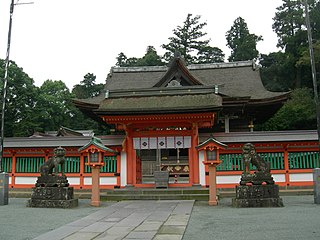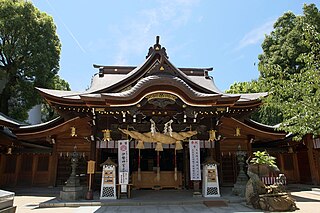 W
WDazaifu Tenman-gū (太宰府天満宮) is a Shinto shrine in Dazaifu, Fukuoka Prefecture, Japan. It is built over the grave of Sugawara no Michizane (845–903) and is one of the main shrines dedicated to Tenjin, the deified form of Michizane.
 W
WHakozaki Shrine is a Shintō shrine in Fukuoka.
 W
WHikosan Jingū (英彦山神宮) is a Shinto shrine located in Soeda, Fukuoka prefecture, Japan. Located on the boundary between Fukuoka and Oita Prefectures, Hiko-san has been venerated from ancient times as a sacred mountain. It was also a center of training for the Shugendō sect of Buddhism. The shrine is located on the Fukuoka Prefecture side of the mountain. The Jō-gu is located in the innermost part of the shrine grounds on the top of Naka-dake, the center peak of the three Hiko-san peaks. The sanctuary is said to have been built in 740. The Hōhei-den, a large lecture hall built in 1616, and the Kane-no-Torii, a bronze Shinto gateway built in 1637, have both been designated Important Cultural Properties by the Japanese government.
 W
WKamado-jinja (竈門神社) is a Shinto shrine located in Dazaifu, Fukuoka prefecture, Japan. Located at the top of Mount Hōman, which has been venerated from ancient times as a sacred mountain, the shrine is dedicated to Tamayori-bime, Emperor Ōjin, and Empress Jingū. The peripheral zone of Mount Hōman, including the shrine, is a National historic site. It was formerly an imperial shrine of the first rank in the Modern system of ranked Shinto Shrines.
 W
WKashii-gū (香椎宮) is a Shinto shrine located in Higashi-ku, Fukuoka, Japan. It is dedicated to Emperor Chūai and Empress Jingū.
 W
WKōra taisha (高良大社) is a Shinto shrine in Kurume, Fukuoka Prefecture, Japan.
 W
WKurume Suitengū (久留米水天宮) is a Shinto shrine located in Kurume, Fukuoka prefecture, Japan. This shrine is the headquarters for all Suitengū Shrines in Japan.
 W
WKushida-jinja (櫛田神社) is a Shinto shrine located in Hakata-ku, Fukuoka, Japan. Dedicated to Amaterasu and Susanoo, it is said to have been founded in 757. The Hakata Gion Yamakasa festival is centred on the shrine.
 W
WMekari Shrine is a Shinto shrine located in Moji-ku, Kitakyūshū, Fukuoka, Japan.
 W
WMiyajidake Shrine is a Shinto shrine located in Fukutsu, Fukuoka, Japan. It is dedicated to Empress Jingū
 W
WMunakata Taisha (宗像大社) is a collection of three Shinto shrines located in Munakata, Fukuoka Prefecture, Japan. It is the head of the approximately 6,000 Munakata shrines all over the country. Although the name Munakata Taisha refers to all three shrines—Hetsu-gū, Nakatsu-gū and Okitsu-gū—it is commonly used to refer to Hetsu-gū alone. As documented in Japan's second oldest book, Nihon Shoki, the shrines are devoted to the three Munakata goddesses .
 W
WOkinoshima is an island off the coast of Munakata, Fukuoka, Japan. It is considered sacred land by the local Munakata Taisha. The island's population consists of a single employee of the shrine. He is one of about two dozen Shinto priests who spend 10-day intervals on the island, praying and guarding against intruders.
 W
WSumiyoshi-jinja (住吉神社) is the Japanese Shinto shrine at Hakata in Fukuoka Prefecture on the island of Kyushu.
 W
WTanabata-jinja (七夕神社), also known as Himekoso-jinja (媛社神社), is a Shinto shrine located in Ogōri, Fukuoka prefecture, Japan. It is dedicated to Orihime, the Japanese name of the Weaver Girl from the Chinese folk tale The Weaver Girl and the Cowherd. The weaver is celebrated in Tanabata, a Japanese festival.
 W
WUmi Hachimangū (宇美八幡宮) is a Shinto shrine located in Umi, Fukuoka prefecture, Japan. It is dedicated to Emperor Ōjin, Empress Jingū, Tamayori-bime, Sumiyoshi sanjin and Izanagi. In the former Modern system of ranked Shinto shrines, it was classified as a prefectural shrine.